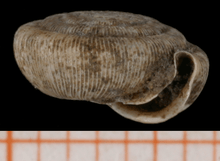Trissexodon constrictus
| Trissexodon constrictus | |
|---|---|
 | |
| Apertural view of the shell of Trissexodon constrictus. Scale is in mm. | |
| Scientific classification | |
| Kingdom: | Animalia |
| Phylum: | Mollusca |
| Class: | Gastropoda |
| (unranked): | clade Heterobranchia clade Euthyneura clade Panpulmonata clade Eupulmonata clade Stylommatophora informal group Sigmurethra |
| Superfamily: | Helicoidea |
| Family: | Trissexodontidae |
| Genus: | Trissexodon |
| Species: | T. constrictus |
| Binomial name | |
| Trissexodon constrictus (Boubée, 1836)[2] | |
| Synonyms | |
|
Helix constricta Boubée, 1836 | |
Trissexodon constrictus is a species of air-breathing land snail, a terrestrial pulmonate gastropod mollusk in the family Trissexodontidae.
Trissexodon constrictus is the type species of the genus Trissexodon.
Distribution
This species is found in France and Spain: from the western Pyrenees to Biscay.[3] It is an endemic species of the western Pyrenees.[3]
Description
The shell is finely and regularly ribbed. It is strongly depressed on the upper side. The lower side is rounded. The shell has 5-6 whorls. The aperture has a characteristic shape. The lip is reflected and forms a "U" shape when seen from above. The umbilicus is deep and covers 1/7 of the shell diameter.[3]
The width of the shell is 6-8 mm; the height of the shell is 3-4 mm.[3]
Ecology
Trissexodon constrictus is found under stones in the soil of humid and shady forests, also between moss and under leaves, from sea level to 800 m, exceptionally to altitudes of 1500 m.[3]
References
This article incorporates public domain text from the reference [3]
- ↑ Mollusc Specialist Group (1996). Trissexodon constrictus. 2006 IUCN Red List of Threatened Species. Downloaded on 7 August 2007.
- ↑ Boubée N. (1836). "Hélice nouvelle. [Helix constricta]". L'Echo du Monde Savant et l'Hermes 3(191): 220. Paris.
- 1 2 3 4 5 6 "Species summary for Trissexodon constrictus". AnimalBase, last modified 26 September 2008, accessed 12 January 2011.
External links
- Tryon G. W. (1895). Manual of Conchology (2)3: page 121. plate 24, figure 38-40.
